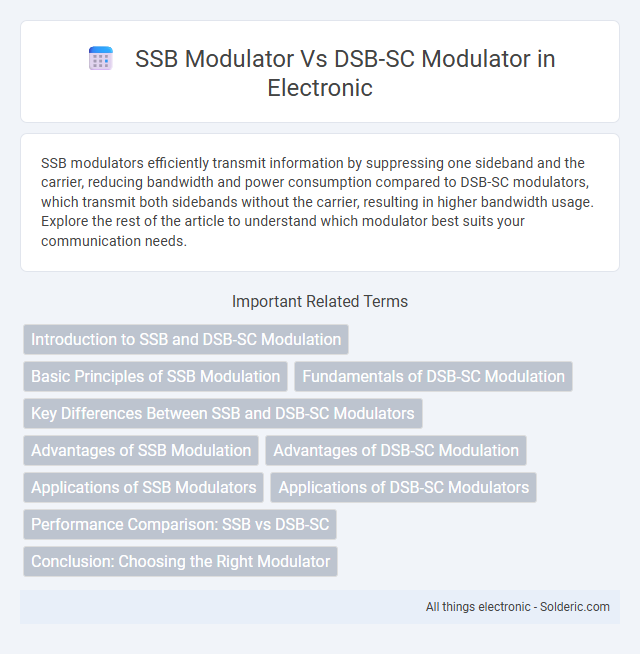SSB modulators efficiently transmit information by suppressing one sideband and the carrier, reducing bandwidth and power consumption compared to DSB-SC modulators, which transmit both sidebands without the carrier, resulting in higher bandwidth usage. Explore the rest of the article to understand which modulator best suits your communication needs.
Comparison Table
| Feature | SSB Modulator | DSB-SC Modulator |
|---|---|---|
| Full Form | Single Sideband Modulator | Double Sideband Suppressed Carrier Modulator |
| Output Spectrum | One sideband (Upper or Lower) only | Both upper and lower sidebands without carrier |
| Bandwidth | Half of the message signal bandwidth | Equal to the message signal bandwidth x 2 |
| Power Efficiency | High (only one sideband transmitted) | Moderate (two sidebands transmitted without carrier) |
| Complexity | High (requires filters or phasing method) | Lower (simpler modulation process) |
| Implementation | Uses filter method or phase-shift technique | Uses balanced modulator to suppress carrier |
| Carrier Transmission | Carrier suppressed | Carrier suppressed |
| Application | Long-distance voice communications, radio broadcasting | Amplitude modulation systems, pilot tone transmission |
Introduction to SSB and DSB-SC Modulation
SSB (Single Sideband) modulation transmits only one sideband of the carrier signal, reducing bandwidth and power requirements compared to traditional methods. DSB-SC (Double Sideband Suppressed Carrier) modulation transmits both sidebands without the carrier, conserving power but requiring more bandwidth than SSB. The choice between SSB and DSB-SC modulation depends on the trade-off between spectral efficiency and system complexity.
Basic Principles of SSB Modulation
SSB modulator transmits only one sideband (either upper or lower) by suppressing the carrier and the opposite sideband, resulting in a more bandwidth-efficient and power-saving signal compared to DSB-SC modulator which transmits both sidebands without the carrier. The basic principle of SSB modulation involves filtering or phase-shifting techniques to isolate and transmit a single sideband of the modulated signal, reducing transmission bandwidth to half that of DSB-SC systems. This selective sideband transmission enhances spectral efficiency and minimizes interference in communication channels.
Fundamentals of DSB-SC Modulation
DSB-SC modulation transmits signals by multiplying the baseband message with a carrier wave, effectively shifting the frequency spectrum without adding a carrier component. This method preserves bandwidth efficiency but requires coherent demodulation for accurate signal recovery, as the carrier is suppressed during transmission. Compared to SSB modulation, DSB-SC uses double the bandwidth since it includes both upper and lower sidebands.
Key Differences Between SSB and DSB-SC Modulators
SSB modulators transmit only one sideband, either the upper or lower, effectively reducing bandwidth to half compared to DSB-SC modulators, which transmit both sidebands simultaneously. SSB modulation offers improved power efficiency by eliminating the carrier and one sideband, whereas DSB-SC requires more power to transmit the full double sideband signal. The complexity of SSB modulators is higher due to the need for precise filtering or phasing methods, while DSB-SC modulators use simpler balanced modulators for generating the double sideband suppressed carrier signal.
Advantages of SSB Modulation
SSB modulators offer significant bandwidth efficiency by transmitting only a single sideband, reducing required spectrum usage by half compared to DSB-SC modulators. This efficiency minimizes power consumption, making SSB modulation ideal for long-distance communication and improving signal clarity in crowded frequency bands. Your communication system can benefit from enhanced spectral efficiency and lower interference when using SSB modulation over DSB-SC modulation.
Advantages of DSB-SC Modulation
DSB-SC modulation offers improved power efficiency compared to standard AM by suppressing the carrier, allowing more transmitter power to be allocated to the sidebands carrying the actual information. This results in better use of bandwidth and increased signal-to-noise ratio, making it advantageous in communication systems where power and bandwidth conservation are critical. You benefit from enhanced transmission quality and reduced interference due to the absence of the carrier signal.
Applications of SSB Modulators
SSB modulators are widely used in long-distance communication systems such as amateur radio, marine, and aviation communications due to their spectral efficiency and reduced bandwidth requirements compared to DSB-SC modulators. These modulators enable clearer signal transmission and reception by minimizing interference and power consumption, making them ideal for high-frequency and mobile communication channels. SSB modulators are also integral in military communication systems where secure and efficient bandwidth usage is critical.
Applications of DSB-SC Modulators
DSB-SC modulators are widely used in communication systems requiring bandwidth efficiency, such as wireless transmitters and point-to-point radio links. Your signal benefits from reduced interference and power usage in applications like amplitude modulation broadcasting and analog video transmission. These modulators excel in scenarios demanding improved spectral efficiency compared to traditional DSB modulation.
Performance Comparison: SSB vs DSB-SC
SSB modulators offer superior spectral efficiency compared to DSB-SC modulators by transmitting only one sideband, reducing bandwidth usage by half. This efficiency minimizes power consumption and interference in communication systems, enhancing signal clarity. Your system benefits from improved performance in terms of signal-to-noise ratio and bandwidth utilization when using SSB modulator technology over DSB-SC.
Conclusion: Choosing the Right Modulator
Selecting the right modulator depends on application requirements such as bandwidth efficiency and complexity. SSB modulators provide better spectrum utilization and reduced power consumption by transmitting a single sideband, making them ideal for long-distance and bandwidth-limited communications. DSB-SC modulators, while simpler and easier to implement, consume more bandwidth and power by transmitting both sidebands, suitable for scenarios where simplicity outweighs spectrum efficiency.
SSB modulator vs DSB-SC modulator Infographic

 solderic.com
solderic.com